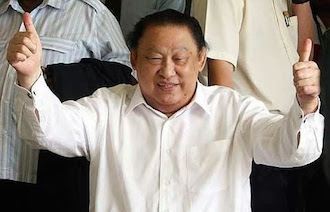The Perwaja Steel Scandal
In fact, Mahathir himself had admitted publicly in 2002 that Perwaja lost RM10 billion in a dialogue with Malaysians in London where he also admitted that there were possible misappropriation of funds and mismanagement in Perwaja.
Rakyat Marhaen
This was what the Wastage of Taxpayer Funds Report said:
Estimated losses: more that RM10 billion
You may have seen online somewhere the long list of scandals in Malaysia that has resulted in the country losing billions and billions of ringgit. Time Magazine quoted an economist at Morgan Stanley in Singapore as saying that the country might have lost as much as US$100 billion since the early 1980s to corruption.
One of these scandals is the Perwaja Steel project which is usually associated with a loss of RM2.56 billion. But it seems like RM10 billion is a more likely figure. In fact, Mahathir himself had admitted publicly in 2002 that Perwaja lost RM10 billion in a dialogue with Malaysians in London where he also admitted that there were possible misappropriation of funds and mismanagement in Perwaja.
Perwaja Steel started in 1982 as a joint venture between the government-owned Heavy Industries Corporation and the Japanese company Nippon Steel Corporation. This was supposed to be a showcase project in Mahathir’s push for industrialization. A steel plant costing RM1 billion was built in Terengganu to supply the domestic needs for steel products.
However, Perwaja encountered production problems and was saddled with large debts. Since the borrowings were in yen – which appreciated significantly at that time – interest payments were getting higher. In 1987 Nippon Steel pulled out of the project. Mahathir then brought in his friend Eric Chia in 1988 to run Perwaja and to turn it around. He was given full authority to do what was necessary to reverse Perwaja’s performance and reported directly to Mahathir.
Another RM2 billion was pumped into Perwaja with government funding and loans from Bank Bumiputra (RM860 million) and EPF (RM130 million). New facilities were built in Terengganu and in Kedah. Eric Chia helmed Perwaja for seven years.
Initially, he seemed to have succeeded in turning around Perwaja but after he resigned abruptly in 1995 it became clear that that was not the case. Total losses had increased to RM2.49 billion from RM1 billion when Eric Chia took over. Perwaja was crippled by additional debts amounting to RM5.7 billion.
The new management of Perwaja prepared an internal report where it claimed the following among others:
– inaccurate accounting records
– unauthorised contracts amounting to hundreds of millions of ringgit
– alleged misappropriation of funds
– dubious maintenance contracts amounting to RM292 million (including a contract amount of RM200,000 per month to a company for gardening, cleaning and vehicle maintenance)
– award of RM957 million contract to companies of a long time associate of Eric Chia
In 1999, Anwar made a police report which stated that “He (Eric Chia) in fact repeatedly claimed that his actions had the support and under the directions of Prime Minister Dato Seri Dr. Mahathir. And this is further substantiated with letters written by the Prime Minister himself. With the so-called mandate, the Board was sidelined, tender procedures were blatantly ignored and there were quesitonable, ‘unsatisfactory’ payments made to certain parties.”
After many years of inaction by the ACA and the police, Eric Chia was finally charged for dishonestly authorizing (not pocketing) a payment of RM76 million (0.076 billion) in 2004. This only happened after Mahathir stepped down as PM and Badawi took over. RM76 million is a lot of money but it is miniscule compared to the total loss estimated to be more than RM10 billion. Eventually, Eric Chia was acquitted by the courts in 2007.
The following sums up quite well this costly Perwaja misadventure,
“Perwaja looked like no more than a shining example of a politically conceived, commercially questionable and poorly executed enterprise that predictably failed. Despite lavish funding, a robust economy much of the time and protection from competing imports in the form of both tariffs and quotas, the company was never able to produce steel profitably. It suffered from chronic operating problems and a crushing debt load, including stiff foreign-exchange losses on heavy borrowing abroad. Even after the government decided to swallow RM9.9 billion in accumulated losses and privatize Perwaja in 1996, it continued to flounder.
Yet there was a more sinister side to Perwaja that guaranteed it an exalted place in the pantheon of Malaysian financial scandals. An unknown portion of the RM15 billion or more that the company consumed was ripped off in various rackets and ruses. Although both internal and external reports confirmed that the company was bled white, almost nothing was done to bring the culprits to justice and recover the funds.” – Barry Wain
Sources:
1. Barry Wain (2009) “Malaysian Maverick – Mahathir Mohamad in turbulent times”
2. Lim Kit Siang (2002), “DAP calls for Royal Commission of Inquiry into RM10 billion Perwaja scandal with former ACA director-general Zaki Husin appointed to assist the inquiry to ensure that Malaysia does not get into the Guinness Book of Records in having the most heinous mega scandals without criminals”
OTHER SCANDALS:
1. Bank Bumi scandal (RM10 billion)
2. Maminco-Makuwasa Affair (RM1.6 Billion)
3. Forex scandal in early 90s (RM30 billion)


